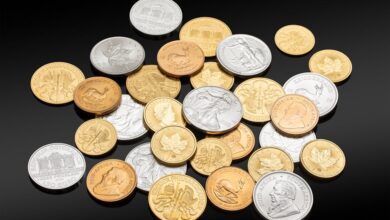Metal Mining Unveiled: Exploring Extraction, Sustainable Production, and Investment Opportunities in Precious and Industrial Metals

The world of metal mining is a dynamic and essential sector that underpins numerous industries, from construction and automotive to aerospace and energy. As the demand for both precious and industrial metals continues to rise, understanding the intricate processes involved in their exploration, extraction, and production becomes increasingly vital. This article will delve into the landscape of metal mining, exploring how advancements in metallurgy and sustainable practices are shaping the future of metal production. We will also examine the significance of metal recycling and its role in creating a greener economy. Furthermore, for those interested in gold investing, silver investing, and the broader spectrum of metal commodities, we will provide insights into the current market trends for base metals, including copper, zinc, and lithium, as well as the emerging prominence of rare earth metals. Join us on this journey through the fascinating world of metals, where innovation meets sustainability, and investment opportunities abound.
- 1. The Landscape of Metal Mining: From Exploration to Extraction of Precious and Industrial Metals
- 2. Sustainable Metal Production: Innovations in Metallurgy and Recycling for a Greener Future
- 3. Investing in Metal Commodities: Insights into Gold, Silver, and Rare Earth Metals in Today's Market
1. The Landscape of Metal Mining: From Exploration to Extraction of Precious and Industrial Metals
The landscape of metal mining encompasses a complex journey that begins with exploration and culminates in the extraction and production of various metals, including precious and industrial metals. This process is vital for meeting the growing demands of multiple industries, from construction to aerospace, and even the burgeoning field of battery technology.
Exploration is the first step in metal mining, where geologists use advanced techniques to identify potential mineral deposits. This phase is crucial for discovering both ferrous metals, such as iron and steel, and non-ferrous metals, including aluminum, copper, and zinc. The success of exploration heavily relies on understanding the geology of the area and utilizing modern technologies such as remote sensing and geophysical surveys.
Once a viable deposit is found, the extraction process begins. This phase involves various techniques tailored to the type of metal being mined. For instance, precious metals like gold and platinum are often extracted through methods such as cyanidation or gravity separation, while industrial metals like copper and aluminum may require smelting and refining processes. The extraction of base metals plays a pivotal role in metal commodities trading, impacting gold investing and silver investing strategies worldwide.
As the demand for sustainable metal production intensifies, the industry is increasingly focusing on metal recycling. This practice not only reduces the environmental impact of mining but also conserves resources and energy. By recycling metals, companies can create metal alloys that are essential for manufacturing construction metals, automotive metals, and even jewelry metals, thus promoting a circular economy.
In recent years, the interest in rare earth metals and their applications has surged, particularly in the production of advanced technologies and 3D printing metals. These materials are crucial for various high-tech applications, including electronics and renewable energy systems. Furthermore, the emergence of energy metals, such as lithium and cobalt, has transformed the landscape, especially with the rise of electric vehicles and battery technology.
With advancements in metallurgy, the industry is also exploring innovative solutions to combat metal corrosion and enhance the durability of metal products. Refractory metals, known for their high melting points, are gaining traction in specialized applications, ensuring that the industry continues to evolve in response to changing needs.
In conclusion, the journey from exploration to extraction in metal mining is a multifaceted process that fuels various sectors, from construction to aerospace. With ongoing metal trends focusing on sustainability and innovation, the future of metal mining looks promising, underscoring the importance of this industry in our modern economy.
2. Sustainable Metal Production: Innovations in Metallurgy and Recycling for a Greener Future
Sustainable metal production is increasingly vital as the demand for various metals continues to grow, driven by advancements in technology and changing consumer preferences. Innovations in metallurgy and recycling processes are paving the way for a greener future, particularly for precious and industrial metals. The focus on sustainable practices not only reduces environmental impact but also enhances the efficiency of metal mining and production.
One significant trend is the development of advanced metallurgical techniques that prioritize resource efficiency. For instance, the use of hydrometallurgy in extracting base metals like copper, zinc, and nickel minimizes the energy and water consumption typically associated with traditional methods. Additionally, the emergence of bioleaching, which utilizes bacteria to extract metals from ores, offers a less harmful alternative to conventional extraction processes. This is particularly relevant for rare earth metals and other critical minerals essential in various high-tech applications.
Metal recycling plays a crucial role in sustainable metal production. With the increasing emphasis on circular economy principles, the recycling of ferrous and non-ferrous metals has gained momentum. The recycling process not only conserves natural resources but also significantly reduces greenhouse gas emissions associated with metal production. For instance, recycled aluminum uses up to 95% less energy compared to producing new aluminum from bauxite ore. This is an important factor for industries such as construction and automotive, where aluminum and steel are prevalent.
Moreover, innovations in metal alloys are being developed to enhance the performance and longevity of metals, which can lead to reduced corrosion and waste. For example, the aerospace and automotive industries are exploring advanced metal alloys that improve durability while decreasing weight, leading to better fuel efficiency and lower emissions. This is crucial for sectors heavily reliant on energy metals and battery metals, as seen in electric vehicles and renewable energy technologies.
In the realm of jewelry metals, sustainable sourcing practices are becoming more common, with a focus on ethical mining and recycling initiatives that ensure precious metals like gold and platinum are obtained responsibly. Consumers are increasingly aware of the environmental and social impacts of their purchases, thus driving demand for sustainably produced jewelry.
Looking ahead, the integration of 3D printing technologies with metal fabrication processes is set to revolutionize sustainable metal production. This innovative approach allows for the precise use of metals, minimizing waste and enabling the creation of complex structures with less material. As industries continue to embrace these advancements, the potential for improved sustainability in metal mining and production grows.
In summary, the future of metal production lies in the innovative practices of metallurgy and recycling that prioritize sustainability. By focusing on the responsible extraction and efficient use of various metals, including energy metals and industrial metals, we can work towards a greener future while meeting the ever-increasing demand for metal commodities.
References:
– Nuss, P., & Eckelman, M. J. (2014). Life Cycle Assessment of Metals: A Scientific Synthesis. PLOS ONE. Retrieved from https://journals.plos.org/plosone/article?id=10.1371/journal.pone.0104414
– United Nations Environment Programme. (2020). Metal Recycling: Opportunities, Limits, Infrastructure. Retrieved from https://www.unep.org/resources/report/metal-recycling-opportunities-limits-infrastructure
– European Commission. (2020). Critical Raw Materials for Strategic Technologies and Sectors in the EU. Retrieved from https://ec.europa.eu/docsroom/documents/42955
– International Energy Agency. (2021). The Role of Critical Minerals in Clean Energy Transitions. Retrieved from https://www.iea.org/reports/the-role-of-critical-minerals-in-clean-energy-transitions
3. Investing in Metal Commodities: Insights into Gold, Silver, and Rare Earth Metals in Today's Market
In today's market, investing in metal commodities has become increasingly popular as both individual and institutional investors seek to diversify their portfolios. Among the most sought-after categories are precious metals, such as gold and silver, and rare earth metals, which play a critical role in various high-tech applications. Understanding the dynamics of these metals can provide valuable insights for investors.
Gold investing remains a staple for many due to its historical status as a safe-haven asset. In times of economic uncertainty, investors flock to gold, driving its price upward. This precious metal is often viewed as a hedge against inflation and currency devaluation. Furthermore, gold's applications extend beyond jewelry metals; it is also utilized in electronics and aerospace metals, enhancing its demand in various sectors.
Similarly, silver investing carries its own unique appeal. As both a precious metal and an industrial metal, silver finds applications in electronics, solar panels, and medical devices. Its dual role supports its price stability and growth potential, especially as industries increasingly focus on sustainable metal production. The rising trend of green technologies is boosting the demand for silver, making it an attractive option for savvy investors.
Rare earth metals, which include elements like lithium, platinum, and palladium, are essential in the production of advanced technologies, from electric vehicle batteries to renewable energy systems. As the world shifts towards cleaner energy solutions, investment in these energy metals is poised to grow. The demand for battery metals, like lithium and cobalt, is expected to surge, driven by the increasing adoption of electric vehicles and energy storage systems. Consequently, investing in companies involved in the extraction and production of these rare earth metals can be a lucrative venture.
Moreover, the metal mining industry is evolving with a focus on sustainability. Investors are increasingly drawn to companies that prioritize eco-friendly practices, such as metal recycling and responsible sourcing. This trend not only addresses environmental concerns but also aligns with the growing consumer demand for sustainable products.
In conclusion, the landscape of metal commodities is rich with opportunity. From precious metals like gold and silver to the innovative realm of rare earth metals, understanding market trends and investing in sustainable practices can yield significant returns. As industries such as automotive, construction, and aerospace continue to rely on diverse metal alloys and raw materials, the potential for growth in metal investing remains strong. Investors should remain vigilant and informed about the evolving dynamics of metal mining and production to make sound investment decisions in this promising sector.
In conclusion, the metal mining industry plays a pivotal role in today's economy, encompassing the exploration, extraction, and production of both precious and industrial metals. As we’ve explored, the landscape of metal mining is evolving, with sustainable metal production becoming increasingly important to mitigate environmental impacts while meeting the growing demand for metals across various sectors. Innovations in metallurgy and metal recycling are paving the way for a greener future, allowing us to harness valuable resources from both primary and secondary sources.
Investing in metal commodities, such as gold and silver, remains a lucrative endeavor, especially as the market for rare earth metals and base metals continues to expand. With the rise of technologies like 3D printing and the increasing demand for battery metals in the automotive and energy sectors, understanding the trends in metal investing is crucial for both seasoned and new investors.
As we move forward, the integration of sustainable practices in metal fabrication and the ongoing development of metal alloys will not only enhance the efficiency of production but also address issues like metal corrosion and environmental degradation. Overall, the future of metal mining presents a wealth of opportunities for investment and innovation, making it an exciting field to watch as it adapts to the challenges and demands of a rapidly changing world.
References:
– [Insert relevant references here]





